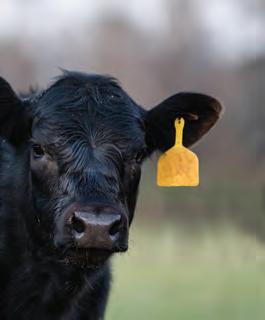


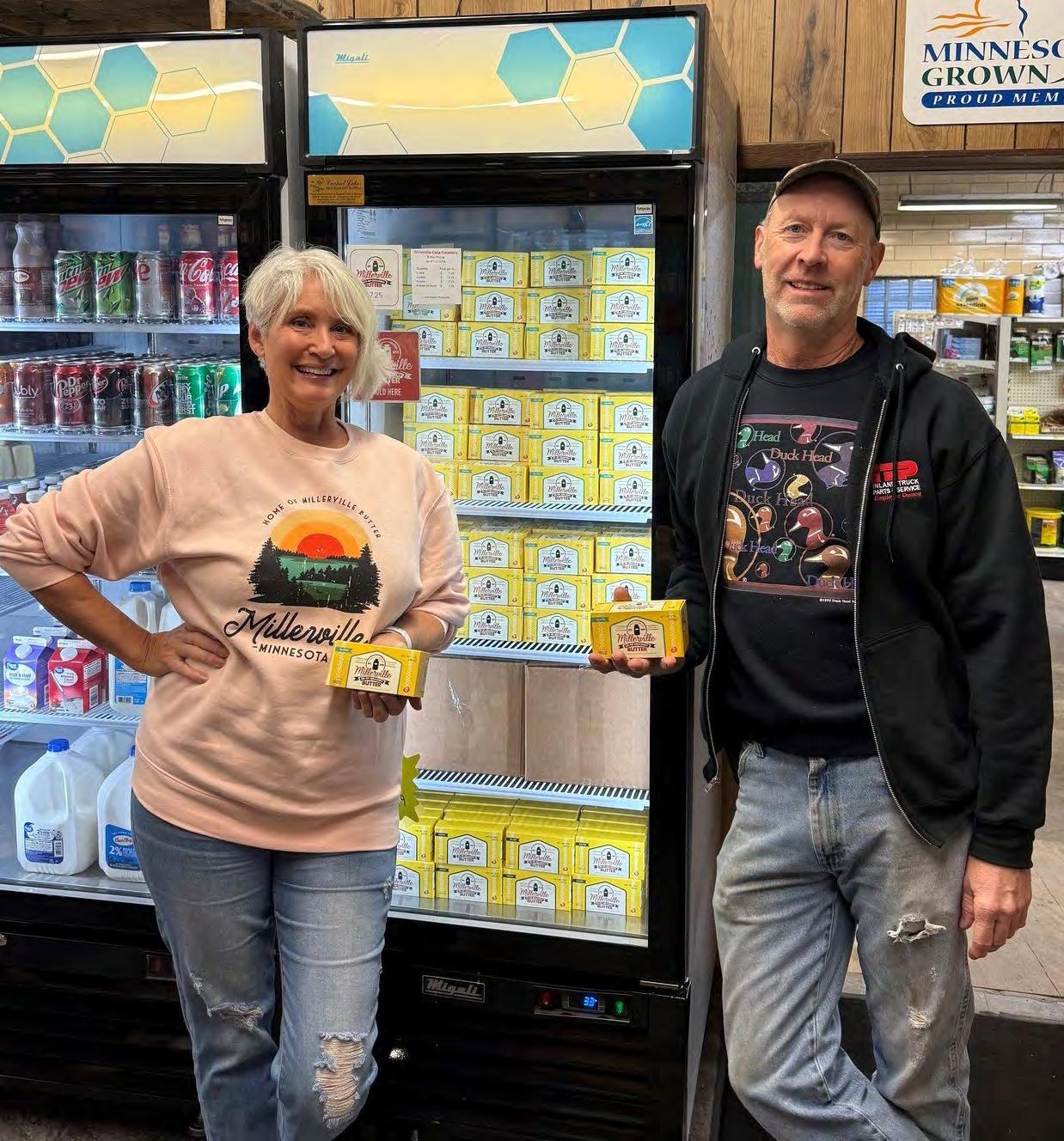
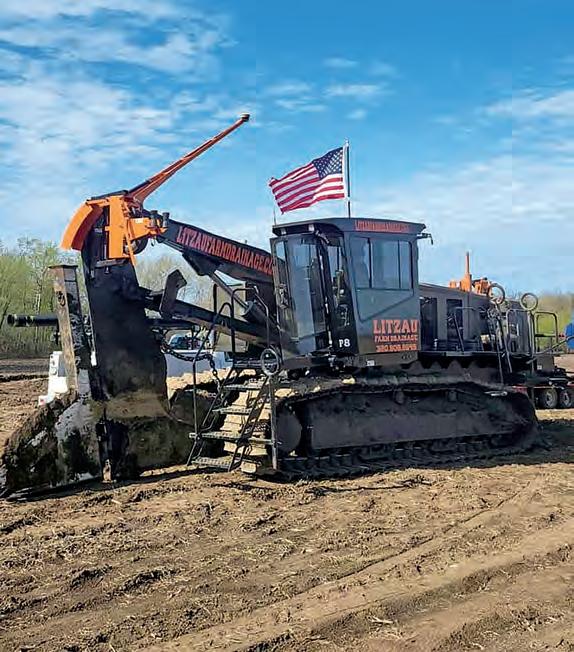

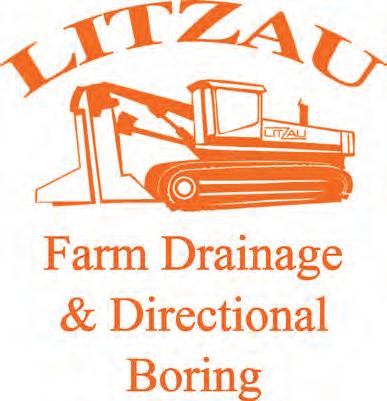
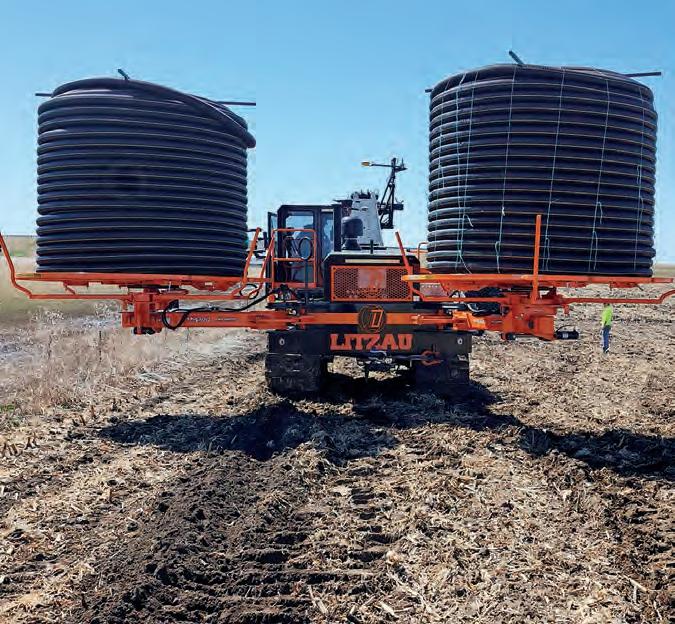













Mark Koehn drove an 85-year-old tractor 1,900 miles from Canada to the Gulf of Mexico to bring awareness of the importance of FFA alumni groups.

EDITOR: Kelly Boldan
MAGAZINE EDITOR: Kit Grode AD MANAGER: Christie Steffel
MAGAZINE DESIGNER: Chris Johnson


Build your business. Grow your bottom line.
When it comes to advertising your business, you need a partner that can get you results. As the largest media organization in the Upper Midwest, we have the audience you need plus the experience and knowledge to make the most of your budget.


By Levi Jones | West Central Tribune
KANDIYOHI — Farming is essential but it comes with plenty of its own dangers, from heavy machinery and flammable materials to other hazards that crop up on the modern farm.
But when incidents do occur, first responders are able to help.
Jamie Swanson serves as the fire chief of the Kandiyohi Fire Department, which covers around 1,000 people. Throughout a typical year, the Kandiyohi Fire Department responds to dozens of calls from farms. While these frequently are fire calls, the department is also prepared to deal with other risks.
Part of the training which first responders do for farm accidents is familiarizing themselves with the tools available to them. These tools range from standard cutters to

more niche items, like a stabilizing beam which the department got last year.
The beam is used to prevent heavy objects from tipping. It is often used in car accidents when a vehicle flips on one side to prevent it from falling.
Much of this equipment is paid by the department’s budget, but there are some donations as well. When the department doesn’t have a tool they need, or if an incident requires more people to manage, they are able to call on other local first responders for help.
“Maybe we need a ladder truck from Willmar or something to come help out. If it is something we know prior, we can ask for that before we get there; it helps out a lot to have that information,” Swanson said.


One of the many dangers of farmwork comes in the form of grain bins. When farmers go into the bins in order to check the grain, they can become stuck or submerged. When this happens, first responders must utilize specialized equipment to remove them.
The most common method of extraction involves a set of metal plates that are dug into the grain around the individual to relieve pressure on their body before they are extracted from the grain.
Kandiyohi Fire Department keeps their extraction tools in a vehicle they have designated as a grain rescue vehicle.
According to Swanson, the department hasn’t seen an incident yet, but the volunteers keep up to date with training in case something does happen.
“We haven’t had one yet. So this is the preparedness that we are seeing. Everything we have is for preparedness. Hopefully, we never have to use it,” Swanson said.
Part of preparedness is having a plan. By having regular practices, emergencies can be avoided and risks can be lowered.
To help with preventing grain bin incidents, Hultgren Farms uses braces to help make sure that workers don’t get stuck in the grain.
“We always have something to hold the person up so they can’t get pulled in. You would be amazed at how quickly these corn
or soybeans can basically collapse,” said Noah Hultgren, a co-owner of the family operation in rural Pennock.
Also, no one works alone around grain. Another employee is always present. By having more than one person assigned to tasks like grain bin management, response to incidents can be much faster.
While grain bin incidents aren’t uncommon, there are many other risks associated with the industry, including something as simple as mud.
“After a light rain, you can drag some mud up onto the road; it can make things really slippery for drivers. We try to scrape that mud off as soon as we can, but we also usually post signs out on the road saying that there might be mud on the road,” Hultgren said. “When we know that we will be tracking mud on the road, we may, if it is possible, go to a different field that goes to a gravel road instead.”
In order to clean mud off of heavier equipment, workers may have to get beneath the machine to wash it. Hultgren employs policies — including making sure that the worker’s body is not entirely under the machine — to minimize the risks.
“It would be easier to basically lay underneath the thing, but it is just not worth the risk of it falling,” Hultgren said.
Farms involve more than your usual number of large vehicles and heavy machinery, as well.
Working with large machinery can involve many different levels of risk.
The Kandiyohi Fire Department has a vehicle outfitted with equipment for grain bin rescues and other agricultural incidents. When a call requires tools which the Kandiyohi Fire Department does not have, the department calls on other local response teams to provide aid.
Machine fires can pose a risk to operators if the machine is not well-maintained, and grain augers, in particular, can pose a serious risk of entanglement, which can result in loss of limbs or worse.
“You hear of a lot of entanglement in augers — more or less people getting entangled into the PTO shaft. As a department, I don’t recall that we’ve had a call for a PTO shaft or something like that before, but it happens,” Swanson said.
The risks of farming can be great without proper safety measures. To help combat the risks of farming, and keep farmers safe, the Upper Midwest Agricultural Safety and Health Center hosts events and publishes resources for farmers to use in making sure that their farm isn’t an accident waiting to happen.
Included in these resources are safety checklists. These lists, published on the organization’s website, include help for working alone, managing manure, preventing fires and first aid among others things.
According to the Upper Midwest Agricultural Safety and Health Center, it is better to work in pairs or groups to avoid incidents worsening without being able to call for help. Hultgren Farms agrees, and makes sure its employees never work alone.
“If there is any time that somebody is going into a grain bin, we always make sure there is someone else there. That is a twoperson thing,” Hultgren said.










For folks living in a farming community, seeing smoke coming from farms isn’t uncommon. Property owners employ controlled burning in order to clear the ground of unwanted vegetation. Burn permits are required in order to properly do a controlled burn.
Kandiyohi Fire Department gets occasional calls to the locations of these controlled burns, and when they do, they check whether or not a burn permit was filed for that area. While these burns are safe when done properly, there always remains the possibility of one getting out of control.
“You do your back burns. So you’ll burn around it or if you are lucky enough to have plowing around it or haul some fire bricks or something like that. For the most part, it is backburning first,” Swanson said of the process.
Swanson recommends checking weather conditions before doing a controlled burn. Ideally, it is best to burn on a dry day with low wind. High winds can carry the fire outside of the controlled area and allow it to spread more than it should.
When fields do catch on fire or get out of control, first responders are able to backburn in order to fight against it. By starting smaller fires around the location, firefighters are able to put a perimeter on the fire, cutting off fuel for it to expand.
“When we are looking at where to burn, we are considering where we are,” Swanson said. “Are there any structures that are in danger? Is there wind? The big thing is if there’s a farmer out there with a piece of equipment, can they plow up some black dirt.”
Making sure that first responders have all the information they can is an important way to help in an emergency, according to Swanson. If something does occur, Swanson recommends calling 911 immediately and providing as much info as possible.
With a coverage area of more than 1,000 residents, the Kandiyohi Fire Department takes on constant training to stay ready in the event that something happens. Despite two main seasons — planting in the spring and harvest in the fall — the work that farmers do is year-round — and so are the potential risks.
“They’re still working; you treat it the same. We don’t train any differently for the season,” Swanson said.

Levi Jones / West Central Tribune
Kandiyohi Fire Chief Jamie Swanson shows the department’s metal cutter in the back of one of the department’s response vehicles on Feb. 21. The tools which response teams use vary based on the type of incident. A network of local first responders is in place to ensure that every fire station has the resources and people that they need to respond to any situation.
“
We
haven’t had [an incident] yet. So this is the preparedness that we are seeing. Everything we have is for preparedness. Hopefully, we never have to use it.
—
Jamie Swanson

“
Levi Jones / West Central Tribune
The Kandiyohi Fire Department’s designated vehicle for grain bin rescue carries a set of interlocking metal plates which are placed in the grain to surround a trapped individual in order to assist with extraction. As of February, when this story was interviewed, the department had not had to use them; however, the firefighters maintain their equipment and training in order to be prepared.













































Butter is cut, weighed and packaged on Thursday, Jan. 16, at Millerville Co-op Creamery Association in Millerville.
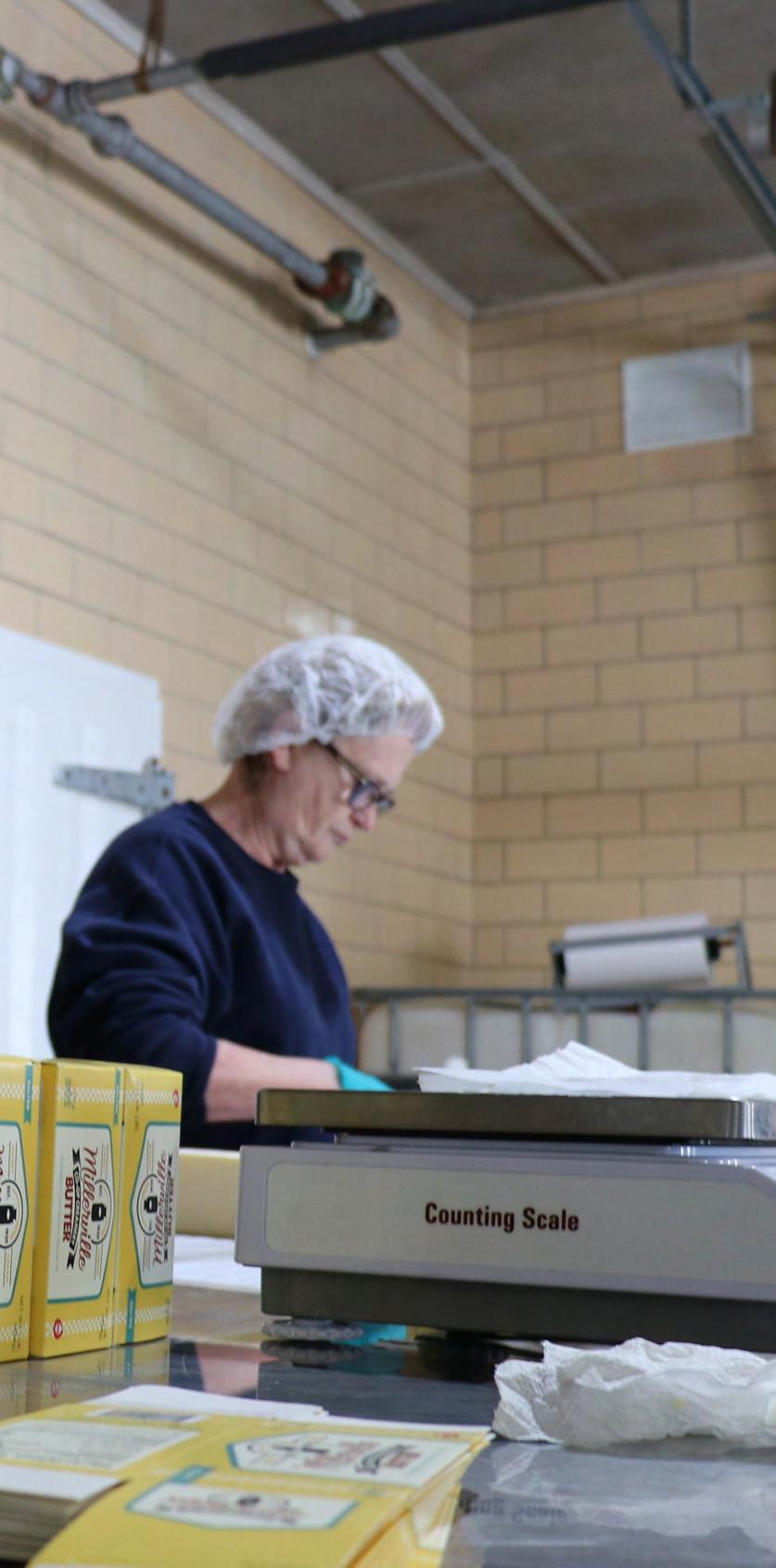

Butter remains at the heart of Minnesota small-town co-op

By Michael Johnson | Agweek
MILLERVILLE, Minn. — A service essential to the community nearly 100 years ago remains an enduring part of it today in Millerville.
Near the epicenter of this central Minnesota community sits the Millerville Co-op Creamery Association. And several times a month a handful of people continue to handcraft butter here like they have since 1929 — with cream and salt. It’s a combination so simple yet so successful.
“It works because the community around here really supports it and it’s a co-op so a lot of the community are members of the co-op,” said Jody Dahlseid general manager of retail, butter and branding for the co-op.
“We’ve learned how to make this awesome butter and we’re still doing it now.”
It’s a small but mighty part of what’s become a full-service cooperative for this region. Here the community and surrounding areas have access to a retail shop with frozen meats, chilled cheese and hand-crafted butter. There’s Millerville merchandise, grilling supplies, automotive and even live bait that are part of the Miller True Value hardware store side of the business. The co-op also has another Miller True Value branch serving the next-door community of Brandon, Minnesota.

Contributed / Jody Dahlseid
Jody Dahlseid, general manager of retail, butter and branding, and Jerry Grothen, general manager of the agronomy and auto service divisions of Millerville Co-op Creamery Association.
“
“ It works because the community around here really supports it and it’s a co-op so a lot of the community are members of the co-op.
— Jody Dahlseid
Next to the creamery building is the agronomy side of the cooperative and behind both is the shop offering auto mechanic services for the area. All are under the Millerville Co-op Creamery Association umbrella. It’s a popular spot in the town of 115.
A lot has changed over nearly 100 years at the creamery. Most recently a change includes appointments of Dahlseid to her position and Jerry Grothen as general manager of the agronomy and auto service divisions. Both bring an abundance of skills that they hope continue to move the business forward.
Thursday, Jan. 16, was butter packaging day at the creamery and both general managers along with staff member Lucy Bitzan were doing their part to turn huge blocks of butter into packaged bricks that consumers buy in the store. Each time they make a batch, they churn out about 1,500 pounds of the stuff.
The creamery got its start when the countryside was covered in smaller dairy farms. Most of those dairy farms are no longer there. That means that the cream now comes from Land ‘O Lakes in Melrose, Minnesota. It’s still milk from the region, but not quite as locally sourced as it once was. The cream undergoes a process here that includes a three-day pasteurization method. Once butter

gets cut by hand in

Johnson / Agweek
Millerville merchandise is a popular part of the business as a way to show off the pride of the Millerville community.
is formed into blocks, packaging day includes slicing the butter by hand, then wrapping and boxing by hand.
Dahlseid said they hope to one day bring some automation to the process to reduce labor costs and because having staff available to complete the work isn’t always easy. But the way they make the butter won’t be changing anytime soon.
As the reach of Millerville Co-op Creamery butter has expanded to over 60 retailers, it’s easier to find the butter. That includes 10 locations in the Fargo-Moorhead area to the south side of the Twin Cities. There’s hope you can find it beyond that region soon. Dahlseid said she’ll be leaning into social media more to help get their product into the hands of more people.
“So hopefully we’ll get new fans for our butter all over the country,” she said. “We’re looking for growth, and I really see that with focus on local foods.”
Dahlseid said the creamery here is more than a business. It’s really part of the identity of the community.
“This creamery is part of the heritage here in Millerville,” Dahlseid said. “It would be really sad if this ever went away. And it’s not going to go away on my watch.”
There’s more than 400 members in the cooperative hoping to see it continue to rise above challenges that may come along.









Retired farmer takes 1,900-mile tractor ride in support of FFA alumni


/ Darrell Larsen

By Michael Johnson | Agweek
HOLDINGFORD, Minn. — Mark Koehn had a dream idling on his to-do list for the last 15 years that he was finally able to check off in the fall of 2024.
Koehn, 69, embarked on a 1,900-mile journey in the seat of his 1940 Farmall M from the Canada-Minnesota border on down to the Gulf of Mexico. The journey, named FFA Agri-Cruise Across the States, was met with an abundance of kindness and generosity as Koehn made the trek in support of FFA alumni awareness.
FFA alumni and supporter chapters are organizations for FFA that often raise money or offer support for chapters. Alumni chapter members don’t have to be alumni of FFA but serve more as boosters for the organization.
For Koehn, it was being a member of FFA 52 years ago that brought him to want to support the organization now that he’s entered retirement. As a charter member of his FFA chapter in Upsala, Minnesota, the organization meant a lot to him.
“It really helped me grow as a person,” he said. “And I’m looking at the opportunities that people in the FFA have now — the career potentials are just incredible.”
Koehn came up with the long-distance idea after reading an article 15 years ago about a man who drove an old John Deere tractor from Oklahoma to North Carolina as a fundraiser and awareness for a veterans group he was affiliated with.
“And I kind of started talking about it, and the more I talked about it, the more intrigued I was so it kind of became a bucket list thing for me to do,” Koehn said.
What better way to combine his bucket list idea with a cause he cared about than this, he thought. So he gathered up other FFA alumni and began scheming a plan to make it happen. They formed a Facebook page, started a fundraising account and began retrofitting his old tractor to be ready for the highway. That included adding a canopy, tool boxes and gas tank storage. Koehn ended up pulling a camper behind the tractor so he had a place to stay just about anywhere he ended up.
Not a camping person, he managed to stay comfortable on the adventure. He found campgrounds, church lots, private property or business parking lots to stay along the way.
“Kind of wherever I could find a flat spot to stay,” Koehn said.
The Farmall M tractor he used for the journey was purchased by Koehn’s father in 1980. In a farm auction about six years ago, Koehn bought that tractor for himself. He had it fully restored by students at the Holdingford High School in Holdingford, Minnesota.
“So I was pretty confident in the tractor,” Koehn said. “Concerns were being on the road going 15, 16, 17 miles per hour, and being hit by a car.”
The tractor and camper were equipped with amber flashers and slow moving signs. Another concern was riding into hurricane weather. The journey was mostly not affected by weather, except for the first day when he was hit with heavy rains in northern Minnesota.
With a top speed of about 16.5 miles per hour, Koehn planned his route last winter to avoid busy highways. The freeway was a big no-no, but he was still able to travel basically straight south with only a few road closures that had him rerouting. A starter failure in Iowa and stuck gears in Texas were the biggest hiccups in the journey, but both times, locals managed to help Koehn get back on the road quickly.
What began on Sept. 16, in Lancaster, Minnesota, ended at the Gulf of Mexico 21 days later. He managed about 125 miles a day, with about 100 miles on a tank of gas. Putting in those long days on the road was mostly mentally fatiguing as he had to keep a constant watch for traffic as he drove on at a fraction of the speed of those around him.
“So when I found a place to park at night, I took a shower, and I made myself some supper, and I did a whole bunch of Facebook entries, and looked at the map where I was going to confirm my route for the next day,” Koehn said. “And most of the time, by 8:30 (p.m.), I was in bed sleeping.”
On top of the long journey to the Gulf, which truly melded him and the Farmall, there were some other good memories engrained in that machine as it was what his wife and children learned to drive tractor with. But due to the costprohibitive nature of shipping the tractor back home (several thousand dollars), Koehn was made an offer and sold the tractor to the Agricultural Historical Museum in Winnie, Texas.

“
[FFA]
really helped me grow as a person. And I’m looking at the opportunities that people in the FFA have now — the career potentials are just incredible.
-Mark Koehn
“
Unable to get the price he was hoping for the camper, Koehn hauled it back home on a trip that took about 19 hours.
There were so many unknowns in embarking on this kind of ride with a tractor an 84-year-old tractor, but the generosity was perhaps what made the trip most rewarding for Koehn. He recalls one elderly woman who waved him down at the end of her driveway on just the second day of the journey. She’d been waiting 20 minutes for Koehn to come by and spent some time reminiscing with him about the old tractor, just like her late husband’s. She sent him on his way with a bag of cookies and a cash donation to the effort.
“I don’t mind telling you I had tears in my eyes from the generosity of this old lady that I had never met before in my life,” Koehn said.
He had hoped to see kindness on the journey but was overwhelmed by just how much he found in every state along the way.
The result of the fundraiser was not as great as he had hoped. The group had an impressive goal of raising $100,000 but gathered about $6,000 in all, mostly from individuals and small businesses along the route. Those funds were divided between the local, state and national FFA organizations.
The FFA Alumni awareness side of this project has been more impressive as Koehn continues to visit area FFA groups and share about how FFA made a difference in his life trajectory. The trip garnered significant attention from passersby and media along the entire route. He thinks he had around 8,000 people following along online with his journey. He knows of three or four new alumni chapters that started after he passed through.
He said it was important to focus on FFA because so few people know about or enter into the FFA alumni chapters that exist. Only about 50% of America’s FFA chapters have an alumni chapter, he said.


“So every chapter that has one, is a better FFA organization than one that doesn’t, because it’s like a booster club,” he said.
Darrell Larson, another Upsala alumni member and former chapter president in 1966-67, thought it sounded like a good idea when Koehn brought up the idea. He volunteered to haul the tractor and camper to the Canadian border to kick off the trek.
Larsen has been involved in FFA and youth enrichment in some way for most of his life. He understands the importance of promoting the good that comes from FFA.
“It’s just self-fulfilling to see the enthusiasm in the youth,” Larsen said of his continued work in judging youth agriculture.
He said he and the others only concern in the project was Koehn’s safety on the highway. They were pleased to see him safely arrive home.
Agriculture has always been a part of Koehn’s life as he went from being named Hog Farmer of the Year in 1987, to entering the property tax assessment field in agriculture-rich Stearns County, Minnesota, to focusing on being “greatest grandfather of all time.”
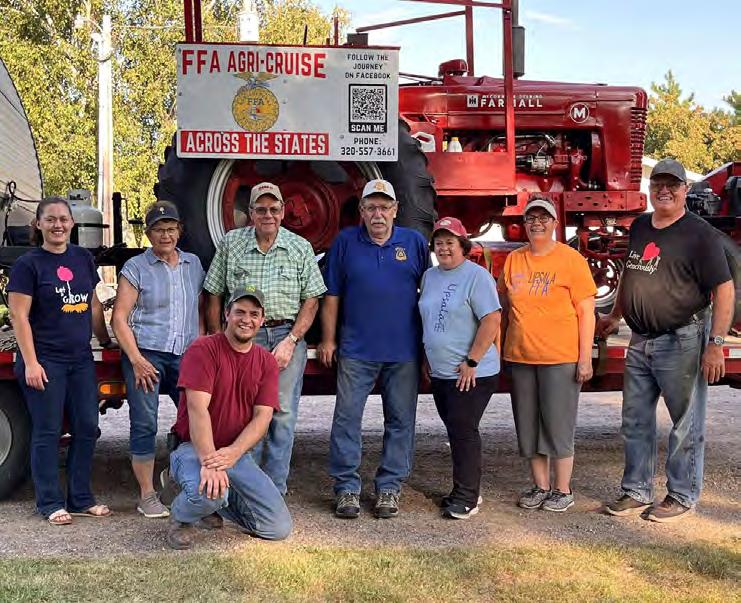
Contributed / Mark Koehn FFA Agri-Cruise Across the States volunteers pose with the tractor including FFA Adviser Audrey Schleper, left, Arlene Larsen, Darrell Larsen, Mark Schleper, Gretchen Schleper, retired FFA Advisor Jane Knott, FFA Alumni President, Mark Koehn and Wayne Woidyla, kneeling.



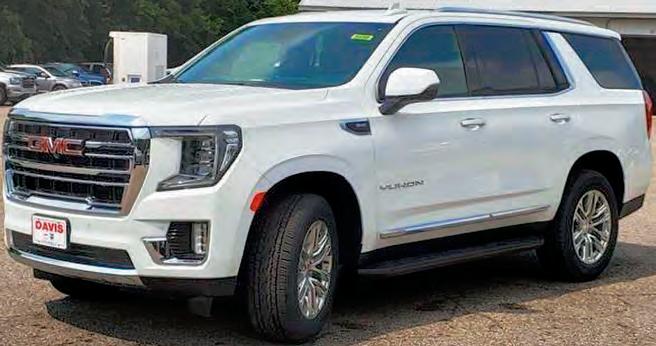

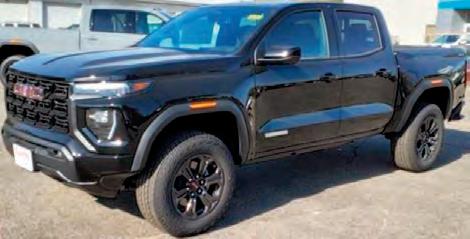












Farm equipment is big in size and in budget. Luckily, there are ways to finance farm equipment that can help farmers get the heavy-duty equipment they need.
The United States Department of Agriculture offers loan programs through the Farm Service Agency so farmers can get the financing they need to start, expand or maintain a family farm. Interest rates depend on the market, but are much lower than conventional bank loans. Native Americans are eligible for tribal loans through the FSA and those can also be used to buy equipment, as can emergency loans for farmers and ranchers recovering from natural disasters.
FSA loans are either guaranteed loans or direct loans. Direct loans come from the FSA directly to the farmer, just as the name implies. Guaranteed loans are made by a USDA-approved traditional lender with FSA backing.
The FSA offers loans to help farmers and ranchers implement climate-conscious practices and equipment. An example the USDA gives is a loan to purchase precision equipment such as strip till fertilizer equipment, no- or reduced-till equipment, livestock facility air scrubber or waste treatment, or fencing equipment installation. The USDA says up to $400,000 can be available for farm operating loans to cover the cost of such equipment.
The FSA also offers microloans up to $50,000 and EZ Guarantee Loans up to $100,000 to cover operating costs, including equipment. These loans are direct loans with a shortened application and reduced paperwork for loan amounts.
Eligibility requirements differ from loan to loan. Some examples of eligibility requirements include U.S. citizenship with the legal capacity to obtain a loan, ability to show a good credit history and the training or experience to manage a farm or ranch effectively.
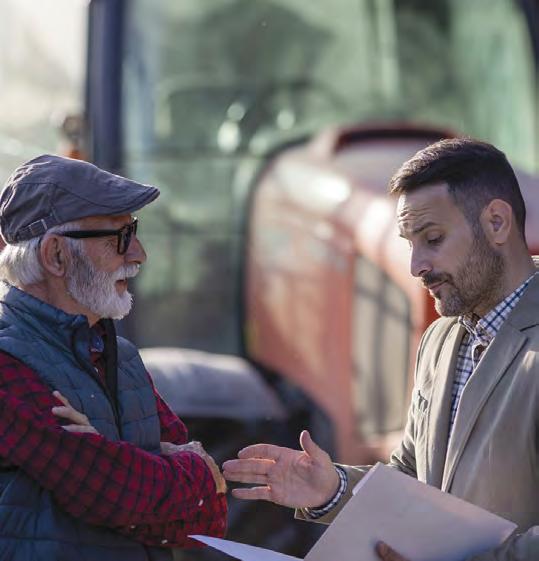
You may need a business plan describing financial and operational goals to help you evaluate progress. The plan demonstrates you’ve seriously thought about the future and that you understand all the parts of your proposed operation. The USDA suggests the plan include:
A mission, vision and goals for your farm or ranch.
► Current assets and liabilities.
► What the farm or ranch will produce and how and where it will market and sell products.
► Whether the amount of income your operation will generate will be enough to pay living expenses.




Levi Jones / West Central Tribune
Katy Schulz, a dairy farmer from Fox Lake, Wisconsin, spoke at the University of Minnesota Extension’s Women in Dairy event about strategies that she and her family employ to make working with siblings easier. The event, held Thursday, Feb. 13, had more than 75 women in attendance, with many coming back as returning guests.

Annual Women in Dairy event gives women in agriculture a chance to network

By Levi Jones | West Central Tribune
HUTCHINSON — Working in agriculture comes with many challenges, oftentimes including navigating a business relationship with family members.
The University of Minnesota hosted the 10th annual Women in Dairy event in February at the Crow River Winery in Hutchinson. The event gave women who own or work on dairy farms the opportunity to network and discuss issues that they face in the industry.
“It’s a great opportunity for women to network and to get together to share their stories. They get a glass of wine and a chance to get away from the farm and spend time with likeminded people,” said Jill Zieroth, coordinator with Minnesota Dairy Initiative.
Speaking at the event was Katy Schulz, a dairy farmer from Fox Lake, Wisconsin, who discussed her experience working with family and how she deals with the difficulties that come along with it.
Schulz was asked to be the guest speaker in large part due to input from attendees the previous year.
“Last year participants said they wanted to hear more about actual farmer stories, so this is a farmer. We try to find those key speakers who meet the needs of our audience,” said Karen Johnson, University of Minnesota Extension educator.
The event was attended by more than 75 women, both young and old, from many backgrounds. Some work with a handful of animals, while others have upwards of 400 cows.
“
I learned how to communicate with people of all different ages, of all different types of farms
and all over the United States.
That experience alone brought me a little bit more of a broadened horizon.
— Katy Schulz

“
Levi Jones / West Central Tribune
Katy Schulz, a dairy farmer in Fox Lake, Wisconsin, was the featured speaker at the Women in Dairy event Feb. 13, in Hutchinson. Schulz spoke about how her family deals with the chaos of being both family and coworkers.
Schulz focused on one stressor the entire audience could relate to — the struggles of working with family. Schulz’s own family tried several methods to help alleviate the stress that can come from that environment.
Schulz’s parents made sure she and her siblings had experience outside of the farm, for one. By having the siblings leave home to pursue other work — with a boss who isn’t related to them and an opportunity to find out what they are good at — they were able to return home with a better understanding of working with family as coworkers.
“I learned how to communicate with people of all different ages, of all different types of farms and all over the United States. That experience alone brought me a little bit more of a broadened horizon,” Schulz said.
The second strategy involved seeing her siblings in multiple roles.
According to Schulz, she sees her siblings as coworkers, as siblings and as best friends. Schulz takes the time to make sure she understands these individual relationships with them as separate so that stress at work doesn’t have as much of an impact.
“My siblings are my best friends, they are my siblings and they are my business partners. And, on some days, they are all three. Other days they are only one of those,” Schulz said.

Levi Jones / West Central Tribune University of Minnesota Extension Educator Karen Johnson gave opening and closing remarks at the Women in Dairy event hosted Feb. 13, at the Crow River Winery in Hutchinson. Johnson has helped to host the event for 10 years. Each year, she gathers feedback from the audience to help decide who the guest speaker will be the next year.
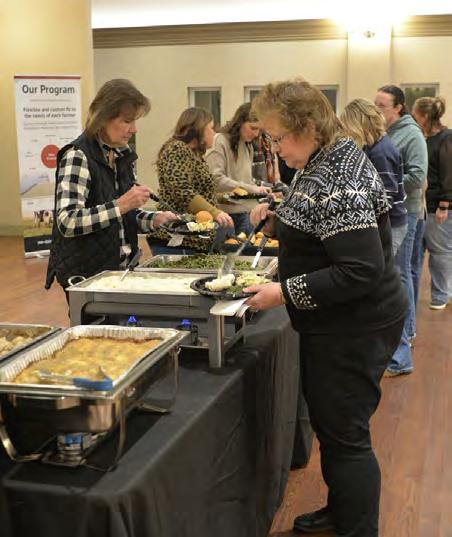
Jones / West Central Tribune Colleen Marketon, of Howard Lake, serves herself from the buffet at the Women in Dairy event hosted by the University of Minnesota Extension on Feb. 13. The event provided supper for the attendees as they listened to a guest speaker. Funding for the program came in large part from local sponsors.

Levi Jones / West Central Tribune
Jenny Lee serves wine at the 10th annual Women in Dairy event hosted at Crow River Winery in Hutchinson on Feb. 13. The annual event is hosted by the University of Minnesota Extension to help give women in the industry a chance to network and listen to guest speakers.
The Women in Dairy conference, hosted through University of Minnesota Extension, has been held every year for the past 10 years, with the exception of one year when it was canceled due to COVID.
Throughout that time, the program has grown significantly as many returning guests bring more people to network and learn about other people in the industry.
“Over the years we’ve tried to hit on a variety of topics that speak well to our attendees. There are a lot that come back year after year that are disappointed if they miss it. They’re very good about offering feedback and how well the speaker’s topic was presented,” Johnson said.
The dairy event is targeted toward women to help promote the dairy farming community. According to Johnson, many attendees of extension programs are male, and organizers wanted to have a space to highlight the work of women in the industry.
“A lot of programs in extension, we tend to see the same folks coming. It is usually the primary farmer — which tends to be male — that is coming to a crops education day,” Johnson said. “We’ve been trying to be very strategic about how we can work with this different segment of our audience.”

For decades, Bremer has helped crop and livestock farmers reach their goals for growth, protect their investments, and preserve
For decades, Bremer has helped crop and livestock farmers reach their goals for growth, protect their investments, and preserve their legacies for future generations. From loans, cash management and insurance, to retirement, estate planning and succession planning, Bremer offers comprehensive solutions for agricultural operations.
While the event is targeted toward local dairy farmers, the program continues to grow in scope as guests tell their friends and return with more people.
Learn how Bremer can help you.
“It spreads a lot through word of mouth. Usually, somebody will come for one year, and they’ll decide that they will enjoy it. Then they’ll bring three of their friends the next year,” Johnson said.











Loon Liquors works with local farmers to offer high-quality organic spirits

By Michael Johnson | Agweek

ST. CLOUD, Minn. — In an industry where fewer people are reaching for beer and wine, two Minnesota men are seeing growth with their one-of-a-kind organic spirits.
Co-founders of Loon Liquors in Northfield, Minnesota, Mark Schiller and Simeon Rossi, began their venture in 2011 after they realized they had a winning drink to share. Some of those drinks now include pre-mixed cocktails like an old-fashioned, cosmopolitan or gin, rum and vodka blends. Their work earned them the2024 Minnesota Cup,the largest statewide startup competition in the nation, in the food/ag/beverage division. In 2025, they plan to open an expanded facility in Northfield that will increase their people capacity and production capacity. And while the two work tirelessly to grow their spirits and the reach of their product, they praise their farmer partners for helping them reach new heights.
“Being a certified organic business meant that we prioritized these relationships with growers,” Rossi said. “That was really, really important to us so we would be able to trace back and understand where our ingredients were coming from.”
Over 90% of their product, by weight, comes from Brian and Tammy Lips, organic farmers at BT Farms out of Nerstrand, Minnesota.

The copper still at Loon Liquors in Northfield, Minnesota.
Brian Lips said the steady market provided through their partnership with Loon Liquors allowed him to switch to full-time farming in 2017.
“I was able to give up my job in town and pay more attention to my farming practices,” Brian Lips said. “With that in mind, we probably tripled out production in the last 10 years with them and it looks like it’s going to go quite a bit more than that yet.”
The partnership offers a fairly closed loop system, Rossi explained at the 2024 Minnesota Organic Conference in St. Cloud, Minnesota.
The Lips grow the grains, including wheat and barley on their 400 acre farm. They bring the grains to the distillery. Distillery staff turn the grain into mash, extracting what they need and returning spent grains to the Lips. That spent grain is fed back to their beef cattle. Not only that, but Tammy Lips even works in the Loon Liquors bottling area to then get the finished product into consumers hands.
Tammy said she sees Loon Liquor continuing to grow, and they, as farmers, plan to grow along with them.
“I think we’re going to continue to grow as suppliers and growers for them as well as in a relationship with them,” she said.

Having more time to focus on farming meant Brian Lips was able to focus on the challenges that can come with organic farming, like controlling weeds. He said the efforts are paying off.
However, even if they are unable to meet the needs of the distillery due to a poor growing year, Loon Liquors and the Lips are aware of a network of organic farmers that can help fill the need.
They use about 2,000 bushels each of barley and wheat. Lips said he can expand up to about twice that much. He knows other farmers that would be willing to hop in to meet the demand.
but it was a preference of the founders to go organic. The organic label is one of the few things consumers have to go by because alcoholic beverages don’t need
locally, that they must trace back to each of the producers.
“
Being a certified organic business meant that we prioritized these relationships with growers. That was really, really important to us so we would be able to trace back and understand where our ingredients were coming from.
— Simeon Rossi
As Loon Liquors looks to grow, they keep communicating with their network of producers to make sure they can meet the needs of each other. Schiller explained that while producers may have some unknowns selling commodities in the open market, they have set prices they can expect when selling to Loon Liquor. They like to know what their expenses are going to be to make their product and the producer likes to know what they can expect to get for their grains as they plan for the next growing season.
“Loon Liquors utilizes 50/50 wheat and barley that’s 100% certified organic. They chose that from an ethics standpoint, Schiller said. He said the same conventional corn that goes to make ethanol also goes into making a great deal of spirits. That may mean beans to some consumers,
to have a nutrition label, Rossi explained. So in many cases, consumers have very little idea what’s in a drink or where the ingredients came from. Loon Liquors wants to be transparent about it and must be in order to remain certified organic. For just one type of spirit, there can be more than 20 organic ingredients, mostly sourced
There may be room for more producers of specialty organic products to also provide ingredients to this business. While some unique ingredients would be easy enough to order from Europe, they agree that local makes the most sense. Rossi said they leave the door open to hearing from producers about what product they have in abundance that might work in their beverages.
“We’re in about 450 liquor stores all over the state of Minnesota,” Schiller said of Loon Liquors reach as of January 2025. They are making plans to enter Wisconsin in the next six months and hope to expand across the nation.
Schiller explained that they’ve managed to stay attractive in the ever-changing trends of alcohol consumption.
The early 2000s were alive with the craft beer movement where consumers moved away from some of the corporate brands to more intense flavors and often locally brewed products. For that to stay popular, the beers kept becoming more and more flavorful and in some cases thicker.
“And then you had porters and stout that literally were the viscosity of motor oil,” Schiller said.
And then in recent years, consumers went to the low flavor, low calorie seltzers. Schiller said consumers have landed back in a place in between, with a little more flavor but in moderation.
“Folks are looking for higher quality,” Rossi said. “Really well balanced, really accessible.”
What makes their product accessible is that they are spirits that come pre-mixed, so you don’t have to try to buy several beverages to get the one flavor you want. Spirits, by definition, are all alcoholic beverages in which


the concentration of ethyl alcohol has been increased above that of the original fermented mixture by a method called distillation, according to Encyclopedia Brittanica.
“If folks are moving away from beer and wine, toward spirits, well they want to be able to enjoy those spirits in a fairly easy, straightforward way, and I see that’s where the market is going,” Rossi said. “And we’ve been able to jump on this on the front end and set ourselves up for success.”
The big focus now is gearing up for a planned opening of a new distillery location in Northfield, Minnesota. This site allows more room, more spirit production and will include food production.
It will include pizza made from wheat that they will mill on-site.
“We are one out of very few pizzerias, like in the country if not in North America, you know, that would be milling our pizza flour on-site, Schiller said. “So it’s super remarkable, but it’s also another opportunity to buy other local ingredients, too.”
The business plans to redefine the craft spirits experience by offering tours of the new facility, offering up Minnesota’s first peat-smoked whiskey and sharing their house-made alcoholic and non-alcoholic drinks come fall 2025.


works with Detroit Lakes, Minnesota, and Maltwerks for malting of their grains.
/
Organic wheat is a key component of Loon Liquors spirit production in Northfield, Minnesota. The grains come from BT Farms, near Nerstrand, Minnesota.











In a combined effort, you as readers and business owners and us as creators and publishers come together to provide our area with a magazine full of important agricultural happenings.
Continued support for our Rooted publication secures our ability to bring West Central Minnesota quality agricultural content. In this way, we are able to show our love and support for our local farmers as well as all of the local businesses that choose to advertise within this publication.
A huge THANK YOU to all of our brilliant advertisers, faithful readers and hardworking farmers. We are immensely grateful for your support and will continue to work diligently every day to earn it.



Dodge County author rails against corporate agriculture in rural America

By Noah Fish | Agweek

“
ROCHESTER, Minn. — Sonja Eayrs was raised on her family’s farm in Dodge County, about 30 miles west of Rochester, which still operates today. Her grandparents moved onto that farm 100 years ago.
“My dad was one of 10 children, and all those 10 children were raised on our farm, and that’s where I was raised,” she said at a recent book signing in Rochester. “There’s something very special about being able to walk the same land as my grandparents and parents and aunts and uncles and other family members.”
“ There’s something very special about being able to walk the same land as my grandparents and parents and aunts and uncles and other family members.
— Sonja Eayrs
Eayrs’ book, “Dodge County, Incorporated: Big Ag and the Undoing of Rural America” has been named a finalist for the Minnesota Book Awards.
It details the first of many lawsuits filed by her parents against Dodge County officials and their neighbors, and their unique challenge against installations of corporate factory farms near their family farm near Blooming Prairie, Minnesota.
Eayrs said her family first were introduced to corporate agriculture in 1993, when the first swine factory farm was erected a mile north of their farm.
“People didn’t really understand what was happening,” she said of the time. “They didn’t understand the significance of corporate agriculture and how it was going to fundamentally change rural America.”
Eayrs’ own involvement began in 2014 when she helped move her mother into an assisted living facility and with her dad who still lived on the farm.
“(Her father) received notice there was yet another swine factory farm going into the immediate area,” Eayrs said. “Today, we have 12 swine factory farms in a three-mile radius.”

Noah Fish / Agweek
A page from Sonja Eayrs’ book “Dodge County, Incorporated: Big Ag and the Undoing of Rural America” at a book signing event.


She said those farms don’t do much to boost the local economy but rather contribute to a massive consolidation of the industry.
“What the industry has done is they have created a pyramid scheme, and at the top of that pyramid is the multinationals — so Hormel, JBS, Smithfield, Tyson, those are the big multinationals at the top of the pyramid,” she said.
At the middle are what Eayrs refers to as the “integrators.”
“The integrators own the supply chain ... “ she said. “Those integrators provide the hogs, and they provide the feed and the veterinary services.”
At the bottom of the pyramid scheme that Eayrs lays out in her book is the contract growers.
“What we used to call farmers,” she said. “The only way that you can get your hogs to market is you have to sign a contract. The days of the independent farmer, unfortunately, have largely collapsed, and so this is a corporate system, and a corporate network that has been created in rural America.”
The reaction to Eayrs’ book, which she began to write in 2019 shortly before her father passed, has been mixed with strong support and strong opposition, she said.
“Either you’re very supportive or you’re very opposed, and there doesn’t seem to be a middle ground, unfortunately,” she said. “My family has put up with tremendous harassment and intimidation that is largely curved because I’ve been so vocal and so outspoken. I frequently tell people that we went to the press not to grab headlines, but for our own protection.”

She said while she’s gotten backlash from the farm community, her book is “absolutely” for farmers — especially ones who recognize themselves as part of the unfair system. Eayrs said she’s been in contact with contract growers who have been taken advantage of in terms of price and delivery of animals to the marketplace.
“They’ve been locked out of the marketplace. This is not a free market,” she said. “If you wanted to take a load of hogs down to Hormel in Austin, for example, they’re not going to let you in.
The only way you can bring a load of hogs to Hormel is if you have signed a contract with an integrator, and the integrator, they’re in charge of the supply chain, so it’s corporate injustice at its best.”




yaroslav astakhov / Kostiantyn / stock.adobe.com
Farmers under 35 now account for 10% of the 3.37 million producers in the United States. According to the United States Department of Agriculture, nearly 70% of those young farmers will hold college degrees.
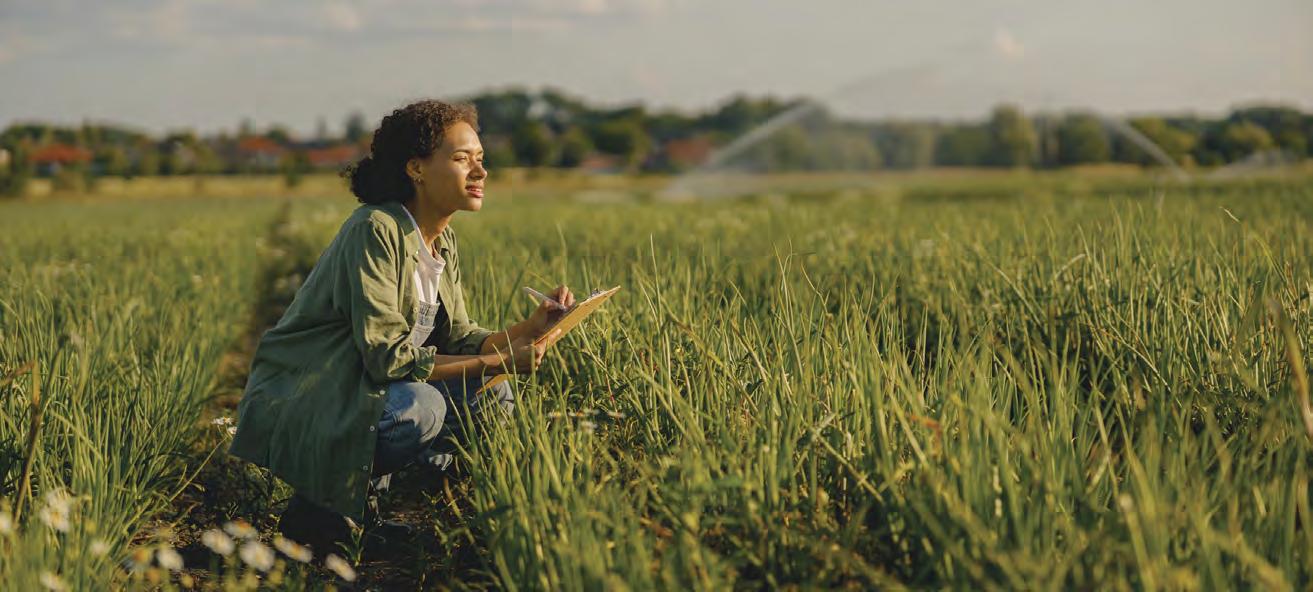


The USDA says nearly 70% of young farmers will soon have college degrees, and farmers under the age of 35 accounted for almost 10% of the country’s 3.37 million producers in 2022.
These younger farmers are more interested in technology than their forebears, researchers say.
“Those who are coming back to the farm are going to be more educated than their parents and grandparents before them,” Brett Sciotto, CEO of Aimpoint Research, told AgWeek. “They intend to do things differently. They grew up in a disruptive era. They don’t necessarily have the same appreciation for the lifestyle that their parents and grandparents did. They don’t want to wake up one morning, work on the farm all day, eat dinner and do it again the next day. They want to run a very efficient operation, they want to make
money. They want to have other interests and do other things.”
Several programs are available to help young producers get their footing.
The American Farm Bureau Federal has a Young Farmers & Ranchers program that includes people ages 18-35. It aims to grow and develop young Farm Bureau members and provide them opportunities and experience through growth in public speaking, issue advocacy, business development, networking, service leadership, media training and telling the story of agriculture.
The National Young Farmers Coalition is a nonprofit that works for justice and champions policies that encourage connections to the land and foster health in the face of climate crisis. It believes, “young farmers, when resourced and trained to share their stories with lawmakers, can remake the food system to
be more equitable, just and in service to our communities and the land.” The group provides training and other resources in food safety, water usage and more.
The USDA’s Farm Service Agency provides youth loans up to $5,000 for people 1020 years old. The money can be used to start and operate income-producing projects in connection with participation in 4-H clubs, Future Farmers of America, a tribal youth group or other agricultural youth organizations.
Farm Credit has programs for young and beginning farmers and ranchers that are 35 years old or younger, have 10 or fewer years of experience, and less than $350,000 in sales. These programs vary from branch to branch and can include training and seminars on topics such as transfer of family farms, risk management techniques, financial skills and establishing a business plan.













